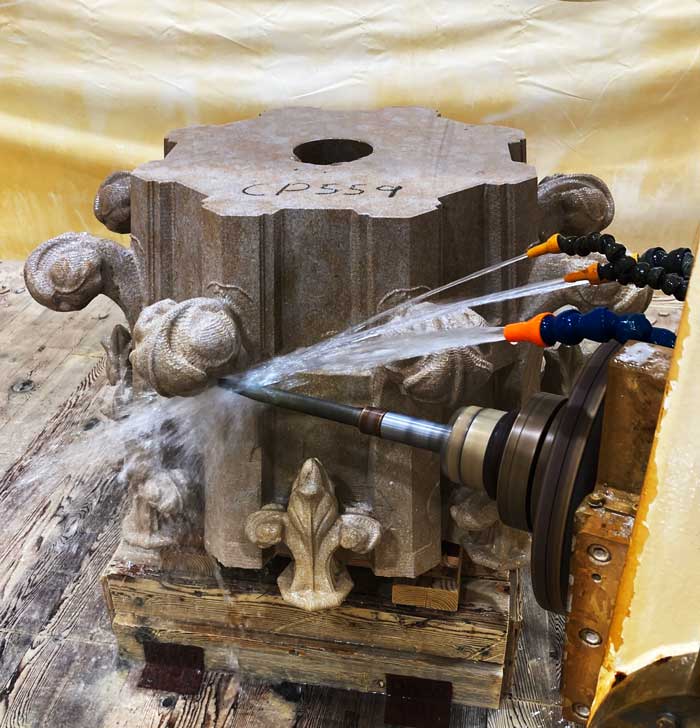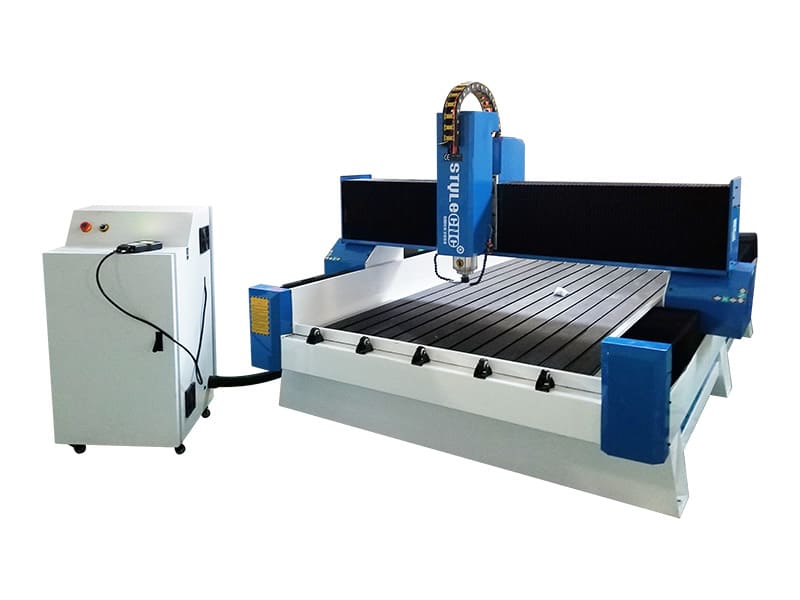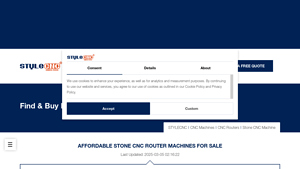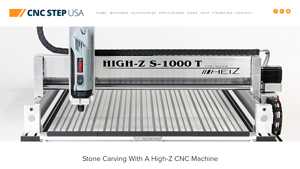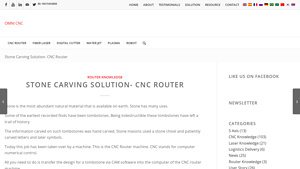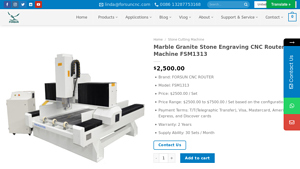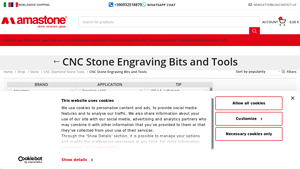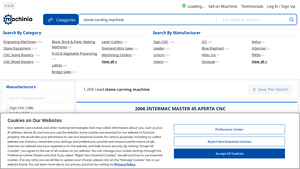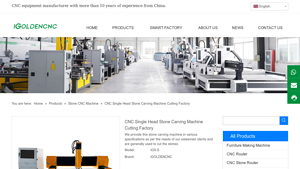Cnc Stone Carving Machine Guide: Type, Cost, Top List…
Introduction: Navigating the Global Market for cnc stone carving machine
Navigating the intricate landscape of sourcing CNC stone carving machines can be a daunting challenge for international B2B buyers, particularly in regions such as Africa, South America, the Middle East, and Europe. The need for precision, efficiency, and cost-effectiveness in stone carving processes has never been more critical. This guide aims to demystify the complexities of the CNC stone carving machine market by providing a comprehensive overview of various machine types, their applications, and essential factors to consider when making a purchase.
Within these pages, you will discover detailed insights into the latest advancements in CNC technology, enabling you to select the right equipment tailored to your specific needs—whether that’s producing intricate sculptures, custom countertops, or detailed architectural elements. We will also address key considerations for vetting suppliers, understanding cost structures, and evaluating machine capabilities, ensuring you make well-informed decisions that align with your business objectives.
Empowering B2B buyers with actionable knowledge, this guide serves as your trusted resource to navigate the global market for CNC stone carving machines. By leveraging the insights provided, you can confidently invest in technology that not only enhances your production capabilities but also positions your business for success in an increasingly competitive landscape.
Understanding cnc stone carving machine Types and Variations
| Type Name | Key Distinguishing Features | Primary B2B Applications | Brief Pros & Cons for Buyers |
|---|---|---|---|
| 3-Axis CNC Stone Carving Machine | Basic three-axis movement; ideal for simple engraving and cutting tasks. | Small-scale stone engraving, signage, and artwork. | Pros: Cost-effective; easy to operate. Cons: Limited complexity in designs. |
| 4-Axis CNC Bridge Saw | Adds a rotational axis for more complex cuts; suitable for intricate designs. | Custom countertops, sinks, and detailed architectural pieces. | Pros: Versatile; enhanced design capability. Cons: Higher cost; requires skilled operation. |
| 5-Axis CNC Stone Cutting Machine | Allows multi-directional movement; ideal for complex shapes and detailed carvings. | Sculpture creation, custom stone furniture, and art pieces. | Pros: High precision; capable of intricate designs. Cons: Expensive; requires advanced training. |
| Desktop CNC Stone Carving Machine | Compact design; suitable for smaller projects and hobbyist applications. | Jewelry making, small decorative items, and prototypes. | Pros: Affordable; space-saving. Cons: Limited working area; lower power. |
| CNC Stone Polishing Machine | Specialized for polishing surfaces post-carving; enhances the finish of stone products. | Finalizing surfaces for countertops, monuments, and statues. | Pros: Improves product quality; essential for professional finish. Cons: Limited to polishing tasks; may require additional machines for carving. |
What Are the Characteristics of a 3-Axis CNC Stone Carving Machine?
The 3-axis CNC stone carving machine operates on three linear axes, making it suitable for basic engraving and cutting tasks. This type of machine is often used in small-scale applications, such as creating signage or simple decorative pieces. B2B buyers should consider the machine’s ease of use and affordability, particularly if they are new to CNC technology. However, its limitations in design complexity may prompt businesses to seek more advanced options as they grow.
How Does a 4-Axis CNC Bridge Saw Enhance Stone Cutting Capabilities?
The 4-axis CNC bridge saw introduces an additional rotational axis, allowing for more intricate cuts and designs. This machine is particularly beneficial for businesses involved in custom countertop production and detailed architectural stonework. When purchasing, companies should evaluate their specific needs for design complexity versus budget constraints. While the 4-axis machine offers greater versatility, it also comes at a higher price point and may require skilled operators.
Why Choose a 5-Axis CNC Stone Cutting Machine for Complex Projects?
The 5-axis CNC stone cutting machine is designed for intricate shapes and detailed carvings, making it ideal for high-end sculpture creation and custom stone furniture. Its multi-directional movement allows for unparalleled precision and creativity in design. B2B buyers should consider the investment required for a 5-axis machine, as it is typically more expensive and necessitates advanced training for operators. However, the return on investment can be significant for businesses focused on premium products.
What Are the Benefits of a Desktop CNC Stone Carving Machine?
Desktop CNC stone carving machines offer a compact solution for smaller projects and hobbyist applications. They are particularly suitable for jewelry making and small decorative items. Businesses looking to test the waters in CNC stone carving may find these machines appealing due to their affordability and space-saving design. However, buyers should be aware of the limited working area and lower power, which can restrict larger projects.
How Does a CNC Stone Polishing Machine Improve Product Quality?
CNC stone polishing machines are specialized tools designed to enhance the finish of stone products after carving. They play a crucial role in finalizing surfaces for countertops, monuments, and statues, ensuring a professional quality that meets customer expectations. When considering a polishing machine, B2B buyers should assess how it fits into their production workflow. While essential for achieving a high-quality finish, these machines are limited to polishing tasks, often necessitating additional equipment for carving.
Key Industrial Applications of cnc stone carving machine
| Industry/Sector | Specific Application of CNC Stone Carving Machine | Value/Benefit for the Business | Key Sourcing Considerations for this Application |
|---|---|---|---|
| Construction and Architecture | Carving intricate architectural elements for buildings | Enhances design precision and reduces labor costs | Look for machines with advanced CAD/CAM compatibility |
| Monument and Memorial Design | Creating customized headstones and memorials | Provides unique, personalized products to clients | Ensure durability and capability for detailed engraving |
| Furniture and Interior Design | Manufacturing stone countertops and decorative pieces | Increases production efficiency and design versatility | Consider machine size and tooling options for various stones |
| Art and Sculpture | Producing detailed sculptures and artistic installations | Facilitates rapid prototyping and artistic expression | Evaluate the machine’s 3D carving capabilities |
| Signage and Advertising | Engraving signage for businesses and events | Offers high-quality, durable signage with aesthetic appeal | Check for engraving speed and material compatibility |
How is CNC Stone Carving Used in Construction and Architecture?
CNC stone carving machines are pivotal in the construction and architecture sectors for crafting detailed architectural elements such as columns, facades, and ornamental features. These machines enable precise cuts and intricate designs that would be labor-intensive and time-consuming if done manually. For international buyers, especially in regions like Africa and the Middle East, sourcing machines that integrate well with local materials and comply with regional building standards is crucial to ensure successful implementation.
What Role Does CNC Stone Carving Play in Monument and Memorial Design?
In the monument and memorial design industry, CNC stone carving machines facilitate the creation of customized headstones and memorials. These machines allow for detailed engravings, including personalized inscriptions and intricate designs, providing clients with unique tributes. Buyers from South America and Europe should prioritize machines that offer high precision and durability, as these features are essential for producing lasting memorials that withstand the test of time.
How Are CNC Stone Carving Machines Beneficial in Furniture and Interior Design?
CNC stone carving machines are increasingly used in the furniture and interior design sectors for crafting stone countertops and decorative pieces. By automating the carving and cutting processes, businesses can achieve higher efficiency and design flexibility, allowing them to offer bespoke solutions to clients. For B2B buyers, especially in Europe and Brazil, it is important to consider machine capabilities for various stone types and the availability of different tooling options to meet diverse design requirements.
What Advantages Do CNC Stone Carving Machines Provide for Art and Sculpture?
In the realm of art and sculpture, CNC stone carving machines enable artists to produce detailed sculptures and installations with remarkable speed and accuracy. These machines allow for rapid prototyping and the ability to execute complex designs that might be unfeasible with traditional methods. Buyers should assess the machine’s 3D carving capabilities and software compatibility to ensure they can achieve their artistic vision effectively.
How Does CNC Stone Carving Enhance Signage and Advertising?
CNC stone carving machines are utilized in the signage and advertising industry to create high-quality engravings for business signs and promotional displays. The precision offered by these machines results in aesthetically appealing and durable signage that can withstand outdoor conditions. For international buyers, particularly in emerging markets, it is vital to consider the engraving speed and material compatibility to ensure efficiency and quality in production.
3 Common User Pain Points for ‘cnc stone carving machine’ & Their Solutions
Scenario 1: Difficulty in Material Compatibility and Performance
The Problem: Many B2B buyers face challenges when selecting a CNC stone carving machine that can effectively handle a variety of stone types. For instance, while a machine may perform well with softer stones like marble and soapstone, it may struggle with harder materials such as granite. This inconsistency can lead to inefficiencies, increased wear on tools, and unsatisfactory product quality, ultimately impacting the buyer’s reputation and profitability.
The Solution: To address this issue, buyers should prioritize machines specifically designed for the range of materials they intend to work with. Conducting thorough research on the machine’s specifications is crucial. Look for models equipped with adjustable feed rates, which allow operators to slow down the cutting speed for harder stones, thereby improving precision and tool longevity. Additionally, investing in a machine with a robust cooling system and dust extraction features will minimize wear on tools and maintain a clean work environment. Consulting with manufacturers about their recommended applications can also provide insight into the best machine choices for specific materials.
Scenario 2: Lack of Skilled Operators and Training Resources
The Problem: A significant concern for many companies is the shortage of skilled operators capable of effectively using CNC stone carving machines. This issue is particularly prevalent in regions with less access to advanced technical education. Without adequately trained personnel, companies may struggle with machine operation, leading to inefficient production processes, increased error rates, and higher operational costs.
The Solution: To overcome this challenge, B2B buyers should seek out suppliers that offer comprehensive training programs as part of their machine purchase. This training should cover not only basic machine operation but also advanced techniques and troubleshooting methods. Online resources, such as video tutorials and user forums, can also be valuable for ongoing learning. Companies can further enhance their workforce by considering partnerships with local vocational schools or technical institutes that offer CNC training programs. This proactive approach not only boosts operational efficiency but also fosters employee retention and satisfaction.
Scenario 3: High Operational Costs Due to Inefficient Processes
The Problem: Many businesses encounter high operational costs related to their CNC stone carving machines, often stemming from inefficient processes and inadequate machine capabilities. For example, a lack of automation can lead to longer production times and increased labor costs, while subpar machines may require frequent repairs and maintenance, further inflating expenses.
The Solution: Buyers should focus on investing in CNC machines that offer advanced automation features, such as automatic tool changers and programmable settings for different stone types. These features can significantly reduce manual intervention, streamline workflows, and ultimately lower labor costs. Additionally, consider machines with a proven track record of reliability and low maintenance requirements. Requesting case studies or testimonials from other buyers can provide insight into the machine’s performance and longevity. Furthermore, implementing a robust maintenance schedule and utilizing predictive maintenance technologies can help identify potential issues before they lead to costly downtime. By optimizing both the machine capabilities and operational processes, businesses can achieve better cost management and improved productivity.
Strategic Material Selection Guide for cnc stone carving machine
What Are the Key Materials for CNC Stone Carving Machines?
When selecting materials for CNC stone carving machines, it is essential to consider their properties, advantages, disadvantages, and suitability for specific applications. Below, we analyze four common materials used in CNC stone carving, providing insights that can guide international B2B buyers in making informed decisions.
How Does Granite Perform in CNC Stone Carving Applications?
Granite is a popular choice for CNC stone carving due to its durability and aesthetic appeal. It has a high density and strength, making it suitable for intricate designs and heavy-duty applications. Granite can withstand high temperatures and pressures, which is beneficial during the carving process. However, its hardness can lead to increased wear on tools and slower machining speeds.
Pros: Excellent durability, high resistance to wear and tear, and a wide range of colors and patterns.
Cons: Higher initial cost and potential for longer machining times due to tool wear.
Impact on Application: Ideal for high-end applications like countertops, monuments, and intricate sculptures.
Considerations for Buyers: Compliance with local standards (e.g., ASTM) is crucial, especially regarding environmental regulations in regions like Europe and the Middle East.
What Are the Benefits of Using Marble in CNC Stone Carving?
Marble is another widely used material for CNC stone carving, known for its workability and luxurious finish. It is softer than granite, allowing for faster machining speeds and less tool wear. Marble’s unique veining and color variations make it a favorite for artistic applications.
Pros: Easier to carve, faster machining, and visually appealing finishes.
Cons: Lower durability compared to granite and more susceptible to scratching and staining.
Impact on Application: Best suited for decorative items, sculptures, and architectural features.
Considerations for Buyers: Buyers should be aware of local sourcing options and the impact of transportation costs, especially in regions like South America and Africa.
How Does Quartz Compare as a Material for CNC Stone Carving?
Engineered quartz, made from natural quartz crystals and resins, is increasingly popular in CNC stone carving. It offers a high degree of customization in terms of color and pattern. Quartz is non-porous, making it resistant to staining and bacteria, which is particularly advantageous for kitchen and bathroom applications.
Pros: Durable, non-porous, and customizable.
Cons: Higher manufacturing complexity and cost due to the engineered nature.
Impact on Application: Suitable for countertops, sinks, and high-traffic areas.
Considerations for Buyers: Ensure compliance with international standards for engineered stone, particularly in Europe where regulations can be stringent.
What Role Does Soapstone Play in CNC Stone Carving?
Soapstone is a softer stone that is easy to carve, making it ideal for intricate designs and artistic applications. It has a natural talc content, which gives it a unique feel and appearance. However, its softness can also make it less suitable for high-stress applications.
Pros: Excellent workability and a unique aesthetic.
Cons: Lower durability and can be easily scratched or damaged.
Impact on Application: Best for artistic pieces, carvings, and decorative applications.
Considerations for Buyers: Understanding local market preferences and sourcing options is vital, especially in regions with a growing interest in artisan crafts.
Summary Table of Material Selection for CNC Stone Carving Machines
| Material | Typical Use Case for cnc stone carving machine | Key Advantage | Key Disadvantage/Limitation | Relative Cost (Low/Med/High) |
|---|---|---|---|---|
| Granite | Countertops, monuments, intricate sculptures | High durability and aesthetic appeal | Increased tool wear and machining time | High |
| Marble | Decorative items, sculptures, architectural features | Easier to carve and visually appealing | Lower durability, susceptible to scratches | Medium |
| Quartz | Countertops, sinks, high-traffic areas | Non-porous, customizable, durable | Higher manufacturing complexity and cost | High |
| Soapstone | Artistic pieces, carvings, decorative applications | Excellent workability and unique aesthetic | Lower durability, easily scratched | Medium |
This strategic material selection guide serves as a valuable resource for international B2B buyers, helping them navigate the complexities of choosing the right materials for their CNC stone carving machines. By understanding the properties, advantages, and limitations of each material, buyers can make informed decisions that align with their specific applications and market demands.
In-depth Look: Manufacturing Processes and Quality Assurance for cnc stone carving machine
What Are the Main Stages of Manufacturing a CNC Stone Carving Machine?
The manufacturing process of CNC stone carving machines is intricate and involves several key stages. Understanding these stages can help B2B buyers evaluate the quality and reliability of the machines they intend to purchase.
1. Material Preparation: How Are Components Selected and Processed?
The first step in manufacturing a CNC stone carving machine is the selection and preparation of materials. High-quality steel, aluminum, and other durable materials are chosen for their strength and longevity. These materials undergo processes such as cutting, machining, and heat treatment to ensure they meet the required specifications for strength and durability.
Precision is crucial at this stage, as the components must align perfectly to achieve the desired functionality of the CNC machine. Advanced technologies like laser cutting and CNC machining are often employed to create the various components, ensuring high accuracy and minimal waste.
2. What Techniques Are Used for Forming Components?
Once the materials are prepared, the forming process begins. This involves shaping the raw materials into the components needed for the CNC machine. Techniques such as milling, turning, and drilling are commonly used to create intricate parts like the machine’s frame, spindle, and tool holders.
High-precision CNC machines are employed during this stage to ensure that each component meets the strict tolerances required for optimal performance. The use of 3D modeling and simulation software allows manufacturers to visualize the final product and make necessary adjustments before actual production.
3. How Is the Assembly Process Conducted?
The assembly of a CNC stone carving machine is a critical phase that combines all the manufactured components into a functional unit. This stage typically involves several sub-assemblies, including the mechanical, electrical, and software components.
Skilled technicians carefully assemble the parts, ensuring that all connections are secure and that the machine operates smoothly. During assembly, alignment and calibration are performed to guarantee that the machine can accurately execute the desired carving and cutting operations.
4. What Finishing Techniques Are Employed?
After assembly, the finishing process enhances the machine’s aesthetic appeal and functionality. This may include painting, coating, or anodizing the components to protect against corrosion and wear.
Additionally, final inspections are conducted to identify any defects or inconsistencies. Quality control at this stage is vital, as it ensures that the machine meets the industry standards for performance and safety.
What Quality Assurance Measures Are Important for CNC Stone Carving Machines?
Quality assurance is integral to the manufacturing of CNC stone carving machines, ensuring that they meet international standards and customer expectations.
Relevant International Standards: Which Certifications Should Buyers Look For?
B2B buyers should look for manufacturers that comply with international quality standards such as ISO 9001, which outlines requirements for a quality management system. Additionally, CE marking indicates that the product meets European safety and environmental standards. For buyers in specific industries, certifications from organizations such as the American Petroleum Institute (API) may also be relevant.
Key Quality Control Checkpoints: How Are They Implemented?
Quality control in CNC stone carving machine manufacturing typically involves several checkpoints:
- Incoming Quality Control (IQC): This stage involves inspecting raw materials and components upon arrival to ensure they meet specified standards.
- In-Process Quality Control (IPQC): During the manufacturing process, continuous inspections are performed to verify that components are being produced correctly and that any issues are addressed immediately.
- Final Quality Control (FQC): Before the machines are shipped, a comprehensive inspection is conducted to ensure that the final product meets all specifications and quality standards.
Common Testing Methods: How Is Quality Verified?
Various testing methods are employed to ensure the reliability and performance of CNC stone carving machines. These may include:
- Functional Testing: Ensuring that all machine functions operate as intended under real conditions.
- Durability Testing: Assessing the machine’s performance under prolonged use to identify potential failures.
- Safety Testing: Verifying that the machine complies with safety regulations and poses no risk to operators.
How Can B2B Buyers Verify Supplier Quality Assurance?
For international B2B buyers, verifying the quality assurance processes of potential suppliers is crucial. Here are several strategies to ensure quality:
Supplier Audits: What Should Be Included?
Conducting on-site audits of manufacturing facilities allows buyers to assess the quality control processes in place. Key areas to evaluate include:
- Production Capability: The technology and processes used in manufacturing.
- Quality Management Systems: Documentation of quality procedures and compliance with standards.
- Employee Training: Ensuring that staff are well-trained in quality assurance practices.
Reviewing Quality Reports: What Information Is Valuable?
Requesting quality assurance reports and certificates from suppliers can provide insights into their commitment to quality. Look for documentation related to:
- Test Results: Evidence of successful testing and compliance with standards.
- Certification Copies: Copies of relevant certifications that demonstrate adherence to quality standards.
Third-Party Inspections: How Can They Enhance Confidence?
Engaging third-party inspection services can provide an unbiased assessment of the supplier’s quality practices. These inspections can cover various aspects, including:
- Material Quality: Verification of incoming materials and components.
- Process Compliance: Ensuring that manufacturing processes align with documented quality standards.
What Nuances Should International Buyers Consider Regarding Quality Control?
International buyers, particularly from Africa, South America, the Middle East, and Europe, should be aware of specific nuances in quality control.
Understanding Regional Standards: What Are the Differences?
Different regions may have varying standards and regulations that affect quality assurance. Buyers should familiarize themselves with local requirements to ensure compliance and avoid potential issues during importation.
Language and Communication Barriers: How to Overcome Them?
Effective communication is critical when dealing with international suppliers. Language barriers can lead to misunderstandings regarding quality expectations. Utilizing clear documentation and possibly translation services can mitigate these risks.
Cultural Differences: How Do They Impact Quality Assurance?
Cultural differences can influence perceptions of quality and business practices. Buyers should be aware of these differences and adapt their approaches to ensure effective collaboration and mutual understanding.
By understanding the manufacturing processes and quality assurance measures associated with CNC stone carving machines, B2B buyers can make informed decisions, ensuring they select reliable suppliers who meet their specific needs and standards.
Practical Sourcing Guide: A Step-by-Step Checklist for ‘cnc stone carving machine’
This guide aims to provide B2B buyers with a systematic approach to sourcing CNC stone carving machines. With the increasing demand for precision in stone carving across various industries, understanding the procurement process is essential. Here’s a practical checklist to ensure you make informed decisions.
Step 1: Define Your Technical Specifications
Before starting your search, outline the specific requirements for your CNC stone carving machine. Consider factors such as:
– Material Compatibility: Identify the types of stone (e.g., granite, marble, quartz) you will be working with.
– Functionality: Determine whether you need a 3-axis, 4-axis, or 5-axis machine based on the complexity of your projects.
Defining these specifications helps narrow down options and ensures the selected machine meets your operational needs.
Step 2: Research Market Trends and Innovations
Stay informed about the latest advancements in CNC technology and market trends. Investigate:
– Emerging Technologies: Look for features like automatic tool changers or advanced cooling systems that improve efficiency and precision.
– Industry Demand: Understanding what is trending can guide you towards machines that will remain relevant and competitive.
This knowledge positions you to choose machines that not only meet current needs but also future-proof your investment.
Step 3: Evaluate Potential Suppliers
Thoroughly vet potential suppliers to ensure reliability and quality. Key actions include:
– Request Company Profiles: Look for information on the supplier’s experience, reputation, and customer service.
– Check References and Case Studies: Ask for testimonials from clients in your industry to gauge satisfaction and performance.
A reputable supplier can provide not only the machine but also ongoing support and service, which is crucial for maintaining productivity.
Step 4: Assess After-Sales Support and Training
Consider the level of after-sales support and training offered by the supplier. Important aspects include:
– Technical Support: Ensure that the supplier provides accessible technical assistance for troubleshooting and maintenance.
– Training Programs: Look for suppliers that offer training for your operators to maximize the machine’s capabilities.
Solid after-sales support can significantly enhance your operational efficiency and minimize downtime.
Step 5: Verify Certifications and Compliance
Ensure that the CNC stone carving machine complies with industry standards and regulations. Look for:
– Quality Certifications: Check for ISO or other relevant certifications that indicate adherence to quality standards.
– Safety Compliance: Ensure the machine meets safety regulations applicable in your region, which is crucial for protecting your workforce.
Verification helps mitigate risks associated with non-compliance and enhances the longevity of your investment.
Step 6: Compare Pricing and Financing Options
Finally, analyze pricing structures and available financing options. Key considerations include:
– Total Cost of Ownership: Look beyond the initial purchase price; consider maintenance, operational costs, and potential downtime.
– Flexible Financing: Explore financing options that can ease the upfront financial burden while allowing you to invest in quality machinery.
A thorough financial analysis helps ensure that your investment aligns with your budget and financial strategy.
Step 7: Plan for Installation and Setup
Once you’ve selected a machine, plan for its installation and setup. Consider:
– Site Preparation: Ensure your facility is ready to accommodate the new equipment.
– Installation Support: Confirm that the supplier provides installation services and initial setup assistance.
Planning for these logistical aspects is crucial to avoid disruptions and ensure a smooth transition to your new CNC stone carving machine.
Comprehensive Cost and Pricing Analysis for cnc stone carving machine Sourcing
What Are the Key Cost Components for CNC Stone Carving Machines?
When sourcing CNC stone carving machines, understanding the cost structure is essential for B2B buyers. The primary components contributing to the overall cost include:
-
Materials: The quality and type of materials used in the machine construction significantly influence pricing. High-grade steel and aluminum are commonly used for robust frameworks, while specialized components like precision spindles can add to costs.
-
Labor: Labor costs encompass the wages for skilled workers involved in manufacturing, assembly, and programming. Regions with higher labor costs will reflect this in the final pricing, making it crucial for buyers to consider sourcing from areas with competitive labor rates.
-
Manufacturing Overhead: This includes costs associated with factory operations, utilities, and equipment maintenance. Efficient manufacturing processes can reduce overhead, impacting the final price.
-
Tooling: Specific tooling for CNC machines, such as custom router bits and cooling systems, adds to the initial investment. Buyers should inquire about the lifespan and replacement costs of these tools.
-
Quality Control (QC): Rigorous QC processes ensure the machines meet industry standards, which can increase costs but ultimately enhance reliability and performance.
-
Logistics: Shipping costs can vary significantly based on the machine’s size, weight, and shipping distance. International buyers must factor in potential tariffs and import duties, which can further affect the total cost.
-
Margin: Suppliers typically apply a margin on their costs. Buyers should understand the standard margins in their specific market to assess pricing fairness.
How Do Price Influencers Affect CNC Stone Carving Machine Costs?
Several factors can influence the pricing of CNC stone carving machines:
-
Volume/MOQ: Buyers often receive better pricing with larger orders. Understanding the minimum order quantity (MOQ) can help in negotiating better rates.
-
Specifications and Customization: Custom features or specifications tailored to specific applications can increase costs. Buyers should clearly define their requirements to avoid unexpected expenses.
-
Materials: The choice of materials not only affects durability but also cost. For example, machines designed for hard materials like granite may be more expensive due to the need for specialized components.
-
Quality and Certifications: Machines that meet international quality standards (such as ISO certifications) may come at a premium but offer better reliability and performance.
-
Supplier Factors: The reputation and experience of the supplier can influence pricing. Established suppliers with a history of delivering quality products may charge more, but they often provide better support and warranties.
-
Incoterms: Understanding the terms of shipment (like FOB or CIF) is vital as they dictate who is responsible for shipping costs and risks, directly affecting the total landed cost.
What Are the Best Practices for Negotiating CNC Machine Prices?
B2B buyers can adopt several strategies to enhance cost efficiency:
-
Conduct Market Research: Understanding market trends and pricing benchmarks helps in negotiations. Buyers should research competitors’ offerings to gauge reasonable price ranges.
-
Leverage Relationships: Building strong relationships with suppliers can lead to better pricing and terms. Long-term partnerships may yield loyalty discounts.
-
Consider Total Cost of Ownership (TCO): Buyers should evaluate not just the purchase price but also ongoing costs such as maintenance, tooling, and operational efficiency. A cheaper initial price may not always lead to the best value in the long run.
-
Be Prepared to Walk Away: Having alternative suppliers can strengthen a buyer’s negotiating position. If a supplier cannot meet price expectations, being ready to explore other options can lead to better deals.
-
Understand Pricing Nuances for International Buyers: International buyers should be aware of currency fluctuations, local taxes, and import regulations that may impact the overall cost. Engaging a local expert can provide valuable insights into these factors.
Conclusion
While the prices of CNC stone carving machines can vary widely based on numerous factors, understanding the cost components and influencers can empower B2B buyers to make informed decisions. It is essential to conduct thorough research, negotiate effectively, and consider the long-term implications of their investment. Prices mentioned in this analysis are indicative and can fluctuate based on market conditions and supplier negotiations.
Alternatives Analysis: Comparing cnc stone carving machine With Other Solutions
Introduction to Alternative Solutions for Stone Carving
When considering investments in stone carving technology, it’s essential to evaluate various solutions that can meet your business needs. While CNC stone carving machines offer precision and efficiency, other methods exist that may suit different operational requirements or budget constraints. This analysis compares CNC stone carving machines against traditional hand carving techniques and laser engraving systems, highlighting their unique advantages and limitations.
Comparison Table
| Comparison Aspect | CNC Stone Carving Machine | Traditional Hand Carving | Laser Engraving System |
|---|---|---|---|
| Performance | High precision, capable of complex designs | Variable precision, labor-intensive | High precision, limited to surface engraving |
| Cost | Moderate to high initial investment | Low initial cost, high labor costs | Moderate initial investment, consumables add up |
| Ease of Implementation | Requires training and setup | Requires skilled artisans | Easier setup, minimal training needed |
| Maintenance | Regular maintenance needed for optimal performance | Minimal maintenance, tool replacement required | Low maintenance, but lens cleaning needed |
| Best Use Case | Mass production, detailed carvings | Custom, artistic pieces, low volume | Engraving logos, designs on stone surfaces |
Detailed Breakdown of Alternatives
Traditional Hand Carving Techniques
Hand carving is the age-old method of shaping stone using chisels and hammers. This approach allows for a high degree of artistic expression and customization, making it ideal for unique, one-off sculptures or intricate designs. However, it is labor-intensive and requires skilled artisans, which can lead to higher labor costs and longer production times. While the initial investment is low, the overall cost can escalate due to the time involved and the need for skilled labor. Additionally, the precision can vary significantly based on the artisan’s skill level, making it less reliable for mass production.
Laser Engraving Systems
Laser engraving systems offer another alternative for stone decoration, particularly for surface-level designs. These systems utilize focused laser beams to engrave patterns, text, or images onto stone surfaces. The main advantages of laser engraving include high precision and the ability to quickly produce intricate designs with minimal setup time. However, laser systems are generally limited to surface engraving and do not provide the same depth or three-dimensional effects that CNC machines can achieve. The initial investment is moderate, but ongoing costs for consumables (like lenses and gas) can add up over time.
Conclusion: Choosing the Right Solution for Your Needs
Selecting the appropriate stone carving technology depends on your specific business objectives and operational constraints. For companies focused on high-volume production with intricate designs, CNC stone carving machines offer unparalleled precision and efficiency, albeit at a higher initial cost. On the other hand, traditional hand carving may be more suitable for bespoke projects where artistry is paramount, but it comes with longer lead times and higher labor costs. Lastly, laser engraving systems present a viable option for businesses looking to add decorative elements quickly and accurately, though they may lack the versatility of CNC machines. By assessing these factors, B2B buyers can make informed decisions that align with their operational goals and budgetary constraints.
Essential Technical Properties and Trade Terminology for cnc stone carving machine
What Are the Key Technical Properties of CNC Stone Carving Machines?
Understanding the technical specifications of CNC stone carving machines is crucial for B2B buyers, particularly when selecting a machine that meets specific operational needs. Here are some essential properties to consider:
1. Material Compatibility
CNC stone carving machines are designed to work with various materials, including granite, marble, quartz, and artificial stones. The compatibility with these materials dictates the machine’s versatility and the types of projects it can handle. For businesses focusing on custom stonework, selecting a machine capable of processing multiple materials can enhance operational flexibility and expand service offerings.
2. Axis Configuration
The configuration of the machine’s axes—commonly 3-axis, 4-axis, or 5-axis—affects the complexity of designs that can be executed. A 3-axis machine can perform basic cuts and engravings, while a 5-axis machine allows for intricate designs, including undercuts and complex shapes. For companies looking to produce detailed sculptures or architectural elements, investing in a higher-axis machine is often essential.
3. Spindle Power and Speed
The spindle’s power, typically measured in horsepower (HP), and its speed (RPM) are critical for determining cutting efficiency and the machine’s ability to handle tough materials. Higher spindle power and speed enable faster processing, which can significantly reduce production time. For B2B buyers, this translates into improved operational efficiency and cost-effectiveness.
4. Precision and Tolerance Levels
Precision in CNC machining is crucial, especially when dealing with detailed carvings or architectural components. Tolerance levels indicate the machine’s capability to produce parts that meet specified dimensions. High precision minimizes waste and rework, which is essential for maintaining profitability in competitive markets. Businesses should prioritize machines with tighter tolerance levels to ensure quality in their final products.
5. Cooling Systems
Effective cooling systems, such as mist cooling or water cooling, are necessary to prolong tool life and improve machining quality by reducing thermal deformation. These systems are particularly important when cutting harder stones like granite, where heat buildup can lead to tool wear and compromised finish quality. B2B buyers should consider machines equipped with robust cooling mechanisms to enhance durability and performance.
6. Software Compatibility
The ability of a CNC stone carving machine to integrate with various CAD/CAM software is vital for design flexibility and ease of use. Machines that support common software platforms enable smoother workflows and quicker project turnaround times. Ensuring compatibility with existing design software is essential for businesses to maintain operational efficiency.
What Are Common Trade Terms Used in CNC Stone Carving?
Familiarizing oneself with industry jargon is essential for effective communication and negotiation in the B2B landscape. Here are some key terms:
1. OEM (Original Equipment Manufacturer)
This term refers to companies that produce components or machines that are used in another company’s end products. When purchasing CNC machines, buyers may seek OEMs to ensure quality and reliability in the machines’ parts.
2. MOQ (Minimum Order Quantity)
MOQ indicates the smallest quantity of a product that a supplier is willing to sell. Understanding MOQ is crucial for B2B buyers as it impacts inventory management and cost-effectiveness, especially when dealing with expensive machinery.
3. RFQ (Request for Quotation)
An RFQ is a formal process where buyers request pricing and terms from suppliers. For companies looking to purchase CNC machines, issuing an RFQ can help compare offers and negotiate better terms.
4. Incoterms (International Commercial Terms)
Incoterms are a set of international rules that define the responsibilities of buyers and sellers in shipping goods. Familiarity with these terms helps B2B buyers understand shipping costs, risks, and responsibilities associated with their machine purchases.
5. Lead Time
This term refers to the time taken from placing an order to the delivery of the product. In the context of CNC stone carving machines, understanding lead times is critical for planning production schedules and ensuring timely project completion.
By grasping these technical properties and trade terminologies, B2B buyers can make informed decisions that align with their operational needs and strategic goals.
Navigating Market Dynamics and Sourcing Trends in the cnc stone carving machine Sector
What Are the Key Market Trends Affecting the CNC Stone Carving Machine Sector?
The global CNC stone carving machine market is experiencing significant growth, driven by advancements in technology and increasing demand for precision in stone fabrication. Key trends include the rise of automated and user-friendly systems that cater to both small-scale artisans and large-scale manufacturers. The integration of CAD/CAM software is becoming standard, allowing for intricate designs and rapid prototyping, which is essential for businesses aiming to stay competitive in markets across Africa, South America, the Middle East, and Europe.
Emerging markets are witnessing a surge in demand for CNC machines, particularly in countries like Brazil and Vietnam, where the construction and decorative stone industries are expanding. Furthermore, the increasing interest in custom stone products, such as personalized tombstones and intricate sculptures, is pushing manufacturers to innovate and offer versatile machines capable of various functions, including cutting, engraving, and polishing.
The focus on sustainability is also shaping sourcing trends, with buyers increasingly seeking machines that minimize waste and energy consumption. Global players are adapting to these market dynamics by enhancing their supply chains and offering machines that align with eco-friendly practices, ensuring they meet the expectations of environmentally conscious buyers.
How Can Sustainability and Ethical Sourcing Influence Your CNC Stone Carving Machine Purchases?
Sustainability is becoming a cornerstone of purchasing decisions in the CNC stone carving machine sector. The environmental impact of stone extraction and processing is significant, prompting buyers to consider the sustainability credentials of their suppliers. Companies that prioritize ethical sourcing practices not only contribute to environmental preservation but also enhance their brand reputation.
Buyers should look for suppliers who demonstrate a commitment to sustainable practices, such as using recycled materials, implementing energy-efficient manufacturing processes, and obtaining certifications that indicate adherence to environmental standards. Certifications such as ISO 14001 for environmental management systems can serve as a benchmark for assessing a supplier’s commitment to sustainability.
Additionally, the demand for “green” materials—such as sustainably sourced stones—can influence sourcing strategies. Engaging with suppliers who provide transparency in their supply chains helps mitigate risks associated with unethical practices, ensuring that your business aligns with broader corporate social responsibility goals.
How Has the CNC Stone Carving Machine Industry Evolved Over Time?
The evolution of CNC stone carving machines can be traced back to the advent of computer numerical control technology in the mid-20th century. Initially used for metalworking, this technology was adapted for stone carving, revolutionizing the industry by significantly enhancing precision and efficiency.
Over the decades, machines have transitioned from basic models to sophisticated systems capable of executing complex designs with minimal human intervention. The introduction of software integration has further facilitated this evolution, allowing users to create intricate designs that were previously impossible with manual methods.
Today, CNC stone carving machines are not only integral to traditional industries, such as gravestone production and architectural detailing, but they are also finding applications in art and design, showcasing the versatility and adaptability of this technology in meeting diverse market needs. As the industry continues to innovate, international B2B buyers are presented with opportunities to leverage these advancements for competitive advantage.
Frequently Asked Questions (FAQs) for B2B Buyers of cnc stone carving machine
-
How do I choose the right CNC stone carving machine for my business needs?
Choosing the right CNC stone carving machine involves evaluating your specific application requirements, such as the type of stone you will be working with (e.g., granite, marble, or softer stones), the complexity of designs, and your production volume. Consider the machine’s capabilities, including its axis configuration (3, 4, or 5 axes), tool compatibility, and software integration. Additionally, assess your budget and the machine’s operational costs, including maintenance and tool replacement. Engaging with suppliers for demonstrations and seeking user reviews can also provide valuable insights. -
What types of stone can be carved with CNC machines?
CNC stone carving machines can handle a variety of materials, including granite, marble, quartz, slate, and soapstone. Softer stones like marble and soapstone are easier to carve and can be processed at faster speeds. However, harder materials like granite require slower feed rates and specialized tools to avoid excessive wear. It’s crucial to ensure that the machine you choose is equipped to handle the specific types of stone you intend to work with, as this affects both the quality of the finished product and the longevity of the tools. -
What are the typical minimum order quantities (MOQs) for CNC stone carving machines?
Minimum order quantities for CNC stone carving machines can vary significantly based on the manufacturer and the specifications of the machine. Generally, larger manufacturers may have higher MOQs, while smaller suppliers might accommodate lower quantities. For custom machines or specialized features, MOQs may also be influenced by production costs and logistics. It’s advisable to discuss your needs directly with suppliers to negotiate terms that align with your business goals, especially if you are a new buyer. -
What payment terms should I expect when purchasing a CNC stone carving machine?
Payment terms for CNC stone carving machines typically range from a deposit requirement (often 30-50% upfront) with the balance due upon delivery or installation. Some suppliers may offer flexible financing options or payment plans, especially for larger purchases. Always clarify the terms before finalizing the deal, including any contingencies related to machine performance or delivery timelines. It’s also prudent to use secure payment methods to protect your investment. -
How can I ensure quality assurance (QA) when sourcing CNC machines internationally?
To ensure quality assurance when sourcing CNC machines, conduct thorough research on potential suppliers. Look for certifications such as ISO 9001, which indicate adherence to quality management standards. Request samples or demonstrations of the machines and inquire about their warranty and after-sales support. Engaging third-party inspection services can also provide an unbiased assessment of the machines before shipment, ensuring they meet your specifications and quality standards. -
What logistics considerations should I keep in mind when importing CNC stone carving machines?
When importing CNC stone carving machines, consider factors such as shipping costs, import duties, and customs regulations in your country. It’s essential to choose a reliable logistics partner experienced in handling heavy machinery to ensure safe transport. Additionally, factor in delivery timelines, as international shipping can be subject to delays. Proper insurance coverage during transit can also safeguard your investment against potential damages. -
How can I customize my CNC stone carving machine to fit my specific needs?
Customization options for CNC stone carving machines can include modifications to machine size, axis configuration, tooling, and software integration. Many manufacturers offer tailored solutions based on your specific requirements, such as enhanced cooling systems for hard stone processing or additional tool changers for increased efficiency. Discuss your needs in detail with suppliers to explore available customization options and the associated costs, ensuring the final machine aligns with your production goals. -
What are the common maintenance practices for CNC stone carving machines?
Regular maintenance is crucial for the longevity and performance of CNC stone carving machines. Key practices include routine cleaning of the machine to remove dust and debris, regular inspection of moving parts, and lubrication of bearings and spindles. Check and replace worn-out tools promptly to maintain cutting precision. Additionally, software updates and calibration checks should be performed periodically to ensure optimal performance. Establishing a maintenance schedule can help prevent costly downtime and extend the machine’s lifespan.
Important Disclaimer & Terms of Use
⚠️ Important Disclaimer
The information provided in this guide, including content regarding manufacturers, technical specifications, and market analysis, is for informational and educational purposes only. It does not constitute professional procurement advice, financial advice, or legal advice.
While we have made every effort to ensure the accuracy and timeliness of the information, we are not responsible for any errors, omissions, or outdated information. Market conditions, company details, and technical standards are subject to change.
B2B buyers must conduct their own independent and thorough due diligence before making any purchasing decisions. This includes contacting suppliers directly, verifying certifications, requesting samples, and seeking professional consultation. The risk of relying on any information in this guide is borne solely by the reader.
Top 9 Cnc Stone Carving Machine Manufacturers & Suppliers List
1. Style CNC – CNC Stone Router Machine
Domain: stylecnc.com
Registered: 2015 (10 years)
Introduction: CNC stone router machine is a fully automatic computer-controlled machine tool capable of carving and cutting various stones including marble, granite, ceramics, jade, and artificial stone. It is compatible with CAD/CAM design software and features professional router bits and a bidirectional tool cooling system to enhance tool lifespan. The machine supports stone lettering, relief carving, shadow…
2. CNC STEP USA – CNC Stone Carving Machines
Domain: cncstepusa.com
Registered: 2011 (14 years)
Introduction: CNC stone carving and engraving machines from CNC STEP USA include German made High-Z and T-rex gantry routers and milling CNC machines. These machines can carve and engrave various stones such as granite, marble, slate, and soapstone. The High-Z CNC machine requires a milling kit for stone work and operates at slower feed rates (2-3 mm per second) when milling hard materials like granite. A mist …
3. Omni – CNC Stone Carving Solutions
Domain: omni-cnc.com
Registered: 2009 (16 years)
Introduction: CNC Stone Carving Solution, also known as CNC Router, is designed for various stone applications including tombstone carving, sign carving, interior decoration, outdoor garden decorative panels, and interior pillar carving. The machine utilizes computer numerical control (CNC) technology to engrave designs into stone with precision. Key features include:
– Ability to carve intricate designs and m…
4. Reddit – CNC Stone Carving Machine
Domain: reddit.com
Registered: 2005 (20 years)
Introduction: CNC machine for carving stones, particularly agates (Mohs hardness of 7). Requires high-quality bits, water cooling, and sintered diamond tooling. The machine should be hardened against abrasive grit with waterproof bellows. It is a slow process, removing about .002″-.004″ of material per pass. Software must compensate for tool wear and trigger alarms for tool changes. Additional processes include…
5. FORSUN – Marble Granite Stone Engraving CNC Router Machine
Domain: forsuncnc.com
Registered: 2020 (5 years)
Introduction: {“Product Name”: “Marble Granite Stone Engraving CNC Router Machine FSM1313”, “Brand”: “FORSUN”, “Price”: “$2500.00”, “Price Range”: “$2500.00 to $7500.00”, “Payment Terms”: “T/T, Visa, Mastercard, American Express, Discover”, “Warranty”: “2 Years”, “Supply Ability”: “30 Sets / Month”, “Applications”: [“Stone industry”, “stone tablet processing”, “art relief”, “advertising”, “decoration”, “ceramic…
6. Facebook – Masterpiece Carving Machine
Domain: facebook.com
Registered: 1997 (28 years)
Introduction: This company, Facebook – Masterpiece Carving Machine, is a notable entity in the market. For specific product details, it is recommended to visit their website directly.
7. Amastone – CNC Stone Engraving Bits
Domain: amastone.com
Registered: 2016 (9 years)
Introduction: CNC Stone Engraving Bits and Tools available from brands like Amastone, Diamar, OMGF, and Stratapax. Products include various router bits for engraving and carving on materials such as marble, granite, quartzite, and ceramics. Key features include multiple tip angles (30°, 45°, 60°, 70°, 90°, etc.), different shapes (flat, round, V-groove), and applications for both engraving and carving. Prices r…
8. INTERMAC – MASTER 33 CNC Machine
Domain: machinio.com
Registered: 2013 (12 years)
Introduction: Used Stone Carving Machines for sale include various models and specifications. Key products include: 1. INTERMAC MASTER 33 CNC Machine (2005) – Weight: 14,250 lbs, 20 HP Electrospindle, Two 14 Position Rotary Tool Racks, Price: $59,999 USD. 2. Hatco DCSB400-3624-2 Large Heated Carving Station – Price: $2,495 USD. 3. NORTHWOOD NW-138S CNC Work Center – Max work area: 13′ x 8′, 15 kW Extreme Duty S…
9. iGOLDENCNC – iGS-S CNC Single Head Stone Carving Machine
Domain: igoldencnc.com
Registered: 2012 (13 years)
Introduction: Model: iGS-S
Brand: iGOLDENCNC
Type: CNC Single Head Stone Carving Machine
Usage: Cutting stones, suitable for stone, tombstone processing, advertising, decoration, arts and crafts industry.
Specifications:
1. Profiled steel welded lathe bed for stability and rigidity.
2. High precision ball screw transmission for accuracy and speed.
3. Imported square linear guide rail for high accuracy and long …
Strategic Sourcing Conclusion and Outlook for cnc stone carving machine
In today’s competitive landscape, strategic sourcing of CNC stone carving machines is essential for businesses aiming to enhance productivity and quality. By understanding the diverse range of machines available, including 3, 4, and 5-axis options, companies can select equipment that aligns with their specific needs—be it for intricate sculptures, headstones, or custom countertops. The precision and efficiency of CNC machines not only reduce labor costs but also improve the consistency and quality of finished products.
Moreover, international buyers should take advantage of the growing market for affordable and advanced CNC technology, especially in regions like Africa, South America, the Middle East, and Europe. Collaborating with trusted manufacturers ensures access to high-quality machines and reliable support, which can significantly enhance operational capabilities.
Looking ahead, the demand for CNC stone carving solutions is poised to expand as industries increasingly adopt automation. Now is the time for B2B buyers to invest strategically in CNC technology to remain competitive and capitalize on emerging opportunities. Engage with suppliers to explore tailored solutions that will drive innovation and growth in your business. Your investment today can shape the future of your operations.
